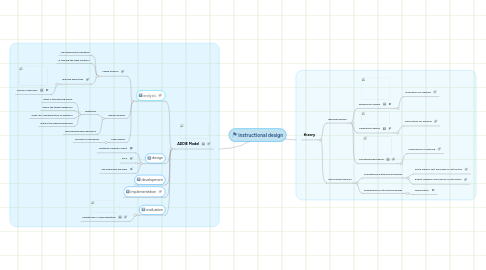
1. ADDIE Model
1.1. analysis
1.1.1. needs analysis
1.1.1.1. The performance equation
1.1.1.2. Is training the right solution?
1.1.1.3. learning objectives
1.1.1.3.1. Bloom’s Taxonomy
1.1.2. learner analysis
1.1.2.1. questions
1.1.2.1.1. What is the learning need?
1.1.2.1.2. Who’s the target audience?
1.1.2.1.3. What are characteristics of learners?
1.1.2.1.4. What's the learning approach
1.1.2.2. learning approach decisions
1.1.3. task analysis
1.1.3.1. concept or procedure
1.2. design
1.2.1. Aesthetic-usability effect
1.2.2. KISS
1.2.3. The alignment principle
1.3. development
1.4. implementation
1.5. evaluation
1.5.1. Kirkpatrick’s 4-level evaluation
2. theory
2.1. learning theories
2.1.1. Behaviorism theory
2.1.1.1. Implication for learning
2.1.2. Cognitivism theory
2.1.2.1. Implications for learning
2.1.3. Constructivism theory
2.1.3.1. implications for learning
2.2. instructional theories
2.2.1. Foundational instructional theories
2.2.1.1. David Merrill‘s first Principles of Instruction
2.2.1.2. Robert Gagné’s Nine Events of Instruction
2.2.2. possibilities of instructional design
2.2.2.1. Gamification
